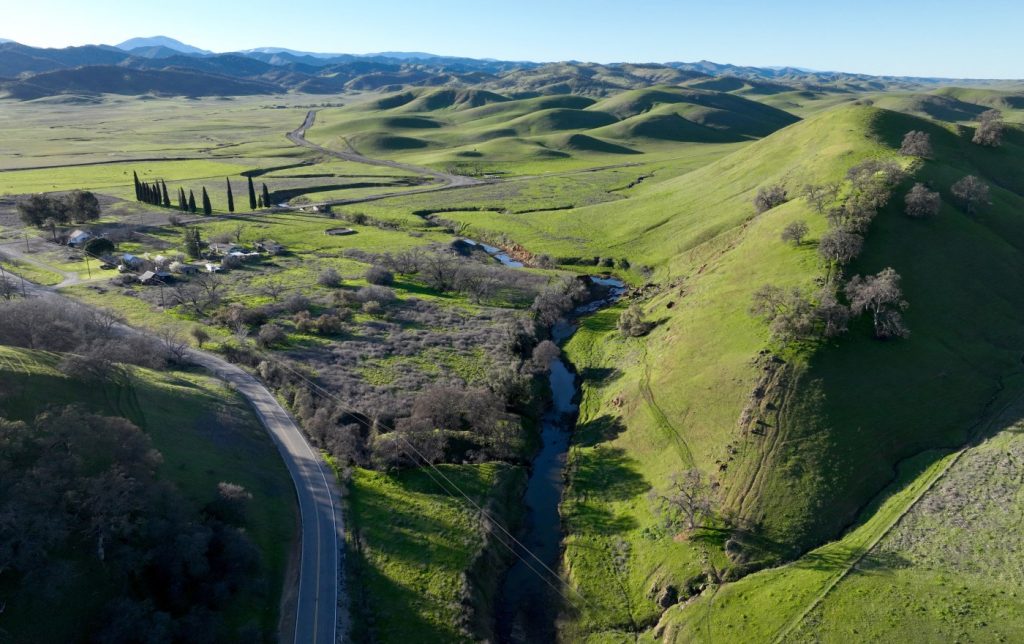Plans to build the largest new reservoir in California in 50 years have taken a significant step forward, following a judge’s decision to reject a lawsuit by environmental groups opposed to it.
The $4.5 billion project, known as Sites Reservoir, is planned for the rolling ranchlands west of the town of Maxwell, about 70 miles northwest of Sacramento.
Sites would be California’s eighth largest reservoir, a 13-mile-long off-stream lake providing water to 500,000 acres of Central Valley farmlands, and 24 million people, including residents of Santa Clara County, parts of the East Bay and Los Angeles.
Late Friday, a judge in Yolo County dismissed a lawsuit from the Sierra Club, Center for Biological Diversity, Friends of the River, and other groups who sued in December, claiming the project’s environmental impact report was inadequate and needed to be redone.
The project is supported by President Biden, Gov. Gavin Newsom, farm organizations, labor unions and about 20 water agencies, including the Santa Clara Valley Water District in San Jose, Zone 7 Water Agency in Livermore, and the Metropolitan Water District in Los Angeles, all of which are partners and would receive water from it.
“California needs more water storage, and we have no time to waste,” Newsom said Tuesday. “Projects like the Sites Reservoir will capture rain and snow runoff to supply millions of homes with clean drinking water.”
The reservoir would store water diverted from the Sacramento River in wet years, for use by cities and farms around the state in dry years.
If completed, Sites would be the largest new reservoir in California since 1979, when the federal government opened New Melones Lake in the Sierra Foothills between Sonora and Angels Camp.
The plan is opposed by the Sierra Club, Friends of the River and other environmental groups who say that filling Sites would divert too much water from the Sacramento River, hurting endangered salmon, steelhead and Delta smelt, and depriving the Sacramento-San Joaquin River Delta of fresh water.
“We’re disappointed by the court ruling,” said John Buse, an attorney with the Center for Biological Diversity in Oakland. “There is considerable momentum for this project. But people need to weigh that against the fact that it is expensive and has limited benefits and significant environmental costs.”
Last July, Newsom signed a law designed to speed construction of water, solar, wind and transportation projects.
Under the new law, lawsuits that are filed under the California Environmental Quality Act, known as CEQA, must be decided within 270 days on such projects. The Sites Reservoir lawsuit was decided in 148 days.
CEQA is one of the state’s landmark environmental laws. Signed by former Gov. Ronald Reagan in 1970, it requires developers to evaluate their projects’ impacts on air pollution, water pollution, wildlife, traffic, noise, and other factors. Newsom, former Gov. Jerry Brown, and other critics have said it has had unintended consequences, stalling for years projects that are important to the state and its economy.
The environmental groups who sued the Sites Project Authority, a collection of local government officials in the Sacramento Valley who are proposing the new reservoir, have until Friday to decide whether to appeal.
The project has nearly all of its funding lined up.
Last week, it was granted another $67 million from the Biden administration. That brings to $519 million the funding it has received from Congress and the administration. It also has received a $2.2 billion loan from the U.S. Environmental Protection Agency, a $450 million loan from the U.S. Department of Agriculture, and $875 million in state funds from Proposition 1, a water bond approved by California voters in 2014. Much of the rest of the money, and the loan repayments, would come from water agencies around the state who buy its water.
If the environmentalists’ lawsuit is not rekindled by a higher court, the final hurdle for the project is to receive water rights from the State Water Resources Control Board, which is appointed by Newsom. Hearings are set to begin in July and run until next April, said Jerry Brown, executive director of the Sites Project Authority.
Brown, who is not related to the former governor, said Wednesday that the project is on track to break ground in 2026 and finish by 2032.
“We need to get it built so that we are prepared for our future,” said Brown, the former general manager of the Contra Costa Water District. “This court ruling shows that California can still build big water projects and do it in an environmentally sensitive way, which we have to do because climate change is affecting our water system, which isn’t set up for what is coming at us.”
Had the reservoir already been built, it would have filled to the top in the past two winters, Brown said. It would hold 1.5 million acre feet — enough for 7.5 million people in a year. The project would have diverted an average of only 6% of the water that flowed through the Delta during January to April, Brown added.
During big winter storms, up to 90% of the water flowing through the Delta flows to the ocean because state and federal pumps at Tracy do not have the capacity to capture more.
Buse, with the Center for Biological Diversity, said pumping in drier times is what worries him.
“Those biggest flow periods are the least controversial,” he said. “The greater concern is when the flows are not as great and they would still be taking water. That’s when it would have more impact on salmon and other fish. Those are critical periods.”
Jerry Brown, executive director of the Sites Project Authority, shows the proposed reservoir site on a map at the agency’s office in Maxwell, Calif., on Thursday, March 14, 2024. (Jane Tyska/Bay Area News Group)


